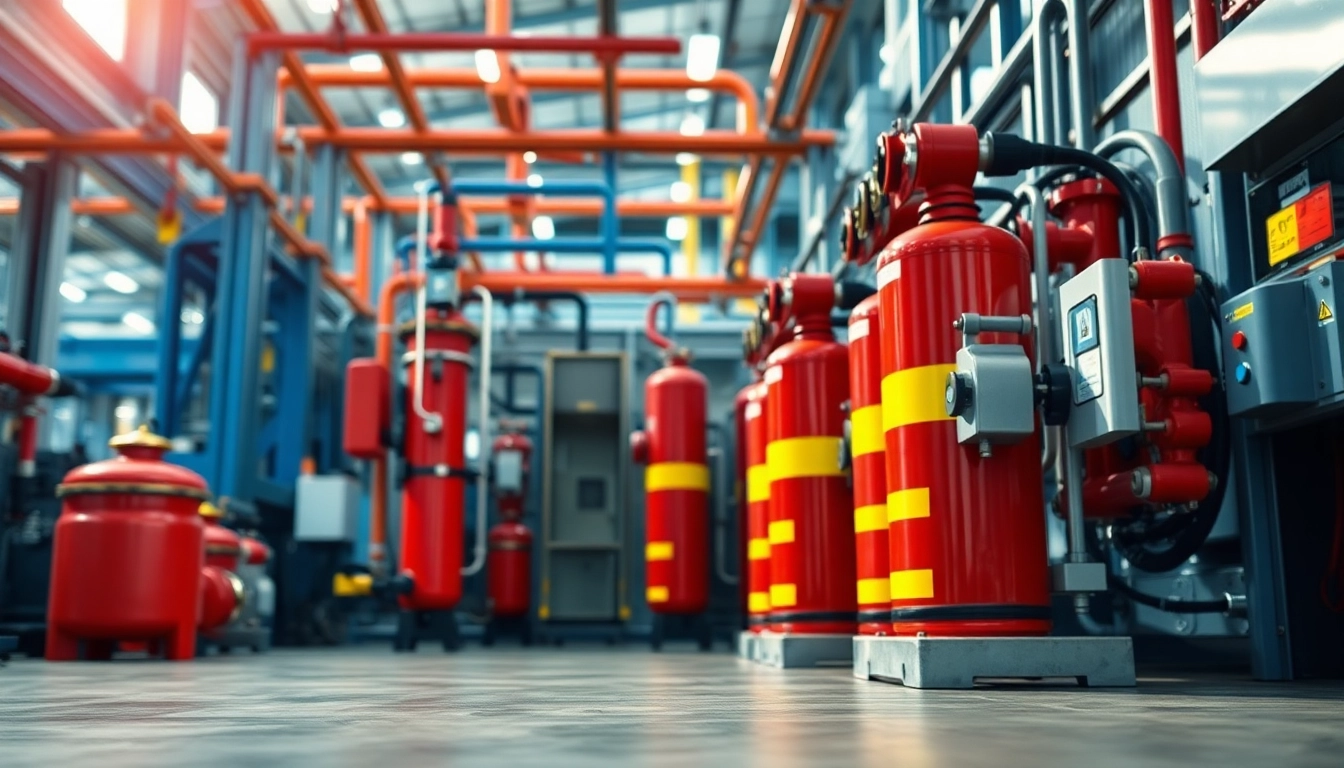
Understanding Fire Protection Fundamentals
Defining Fire Protection and Its Importance
Fire protection encompasses the study, prevention, and suppression of destructive fires. It is not merely a regulatory requirement; it is a critical measure that protects lives, property, and the environment. The consequences of fire incidents can be devastating, leading to loss of life, irreversible damage to real estate, and catastrophic business interruptions. In the U.S. alone, firefighting organizations respond to over 1 million fires each year, leading to billions of dollars in economic losses. Consequently, investing in effective fire protection measures not only safeguards assets but also enhances community safety and resilience.
Key Components of Fire Protection Systems
Effective fire protection is multi-faceted. It can be categorized into several essential components, each playing a vital role in a comprehensive fire safety strategy:
- Detection Systems: These systems, such as smoke detectors and thermal sensors, identify potential fire hazards quickly, enabling timely alerts.
- Suppression Systems: Fire sprinklers, foam systems, and chemical extinguishers are integral in controlling fires and minimizing property damage.
- Fire Doors and Barriers: These structures limit the spread of fire and smoke, providing crucial time for evacuation and firefighting efforts.
- Emergency Lighting and Signage: Proper illumination and clear exit signs facilitate safe egress during an emergency.
- Fire Alarm Systems: These systems communicate immediate threats, providing both audio and visual alerts to those in peril.
Legal Regulations Surrounding Fire Protection
Compliance with fire protection laws and regulations is non-negotiable. The National Fire Protection Association (NFPA) sets the standards for safety, and local fire codes must be observed to ensure safety measures are executed effectively. Regular updates to these regulations require organizations to stay informed and adapt their fire protection plans accordingly. Businesses are often legally obligated to maintain fire safety standards that are consistent with local codes and insurance requirements.
Types of Fire Protection Measures
Passive Fire Protection Techniques
Passive fire protection (PFP) refers to the use of building materials and techniques designed to contain fires or slow their spread. PFP includes fire-rated walls, floors, and doors that keep flames at bay, allowing occupants vital time to evacuate. Concepts like compartmentalization help limit fire impacts and safeguard vital infrastructure. An example of effective PFP is the use of fire-resistant materials in high-rise buildings which significantly increases their safety in the event of a fire.
Active Fire Protection Systems Explained
Active fire protection (AFP) systems are measures that require some action to respond to a fire. These include sprinklers, fire alarms, and standpipe systems. AFP systems respond directly to fire incidents and can significantly mitigate damage. For instance, a properly maintained sprinkler system can reduce fire damage in a commercial premises by 70% according to the NFPA. These systems must be regularly inspected and tested to ensure functional integrity.
Emerging Technologies in Fire Protection
With the rise of intelligent building technologies, the field of fire protection is witnessing innovative solutions such as IoT-connected fire alarms and advanced surveillance systems. These technologies provide real-time monitoring and data analytics that can predict fire hazards before they occur. Artificial Intelligence (AI) can analyze data from varied parameters (like heat, smoke, and occupancy levels) to trigger alerts and notify emergency services effectively and promptly.
Assessing Fire Risks and Developing Strategies
Conducting a Fire Risk Assessment
A thorough fire risk assessment is crucial for identifying potential hazards and vulnerabilities in a facility. This assessment should analyze the building layout, historical incident data, and specific usage of spaces. The process typically involves:
- Identifying potential ignition sources
- Evaluating the presence of combustible materials
- Assessing the effectiveness of existing fire protection measures
- Considering the building structure and occupancy
After risks are identified, they can be prioritized based on their potential impact, enabling the formulation of targeted fire safety strategies.
Creating an Effective Fire Protection Plan
An effective fire protection plan is a comprehensive document that outlines strategies and procedures for preventing and managing fire incidents. Key elements include:
- Management Commitment: Leadership should endorse and support fire safety initiatives heavily.
- Employee Training: Regular fire safety training ensures employees understand their roles in case of a fire.
- Escape Routes and Assembly Points: Clearly defined routes and meeting points must be established for safe evacuations.
- Regular Maintenance and Drills: Continuous checks on fire protection systems and frequent drills to enhance preparedness.
Implementing Training and Drills
Training and drills are not simply formalities; they kindle a culture of safety within organizations. Employees should be trained on:
- Recognizing fire hazards and understanding emergency protocols.
- Operating fire extinguishing equipment and knowing when and how to engage it.
- Conducting orderly evacuations without panic.
Scheduled fire drills reinforce knowledge and preparedness, allowing organizations to refine their response plans based on real-time feedback.
Maintaining and Inspecting Fire Protection Systems
Regular Maintenance Protocols
Regular maintenance of fire protection systems is essential for operational reliability. Proper upkeep involves not just routine inspections but also systematic testing of all components including alarms, sprinklers, and extinguishers. Following manufacturer guidelines for frequency ensures that systems are always in peak condition. Routine inspections should involve:
- Visual checks for any physical damage or interference.
- Functional tests of alarm systems and suppression mechanisms.
- Documentation of maintenance schedules and repairs made.
The Role of Inspections in Fire Safety
Regular inspections, often conducted by certified professionals, are necessary to assess compliance with local fire codes and regulations. Inspections serve to:
- Identify deficiencies in existing fire protection systems.
- Recommend improvements and upgrades to outdated systems.
- Ensure all personnel understands their specific fire safety roles.
As part of the inspection process, reports should be generated to establish accountability and provide actionable follow-up steps.
Documenting and Reporting on Fire Safety Compliance
Documentation is key for maintaining compliance with regulatory demands and corporate policies. Accurate records of inspections, maintenance, training, and incidents provide insight into an organization’s fire safety posture. Reports should detail:
- The frequency and outcomes of inspections.
- Issues found and steps taken to rectify them.
- Response times during fire drills and real incidents.
This documentation not only guides future improvements but also provides necessary proof for regulatory audits and insurance claims.
Future Trends in Fire Protection
Innovations in Fire Safety Equipment
Future fire protection technologies are focused on enhancing detection and suppression capabilities. Innovations include advanced multi-sensor systems that can differentiate between smoke and steam, ensuring false alarms are kept to a minimum. Development of portable fire safety technology is also revolutionizing compliance, allowing facilities to meet stringent regulations without substantial renovation costs. Moreover, fire extinguishers are being redesigned to be more user-friendly and effective across diverse fire types.
The Impact of Smart Technology on Fire Protection
Smart technology is set to redefine traditional fire safety measures. Integrated building management systems now include fire safety features. Smart alarms are linked to mobile devices, providing real-time alerts while allowing remote monitoring of facilities. This technology enables prompt action and effective coordination with emergency services, thus improving response times.
Preparing for Changes in Fire Safety Standards
The fire protection landscape is continuously evolving. Organizations must stay updated on changes in fire safety standards dictated by the NFPA and other governing bodies. Implementing adaptive strategies not only ensures compliance but also fortifies resilience against emerging fire risks. Future preparations should include:
- Proactive engagement with local fire departments and regulators.
- Incorporating emerging technologies to enhance fire protection measures.
- Continual training and re-evaluation of fire safety protocols.





